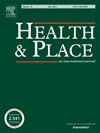Understanding the socio-spatial distribution of “dark retail” in England: Development of a unique retail location dataset
IF 4.1
2区 医学
Q1 PUBLIC, ENVIRONMENTAL & OCCUPATIONAL HEALTH
引用次数: 0
Abstract
Online food delivery services (OFDS) are an increasingly popular way of accessing both ready-to-consume foods and groceries. Such foods are sometimes delivered from facilities not open to the public - so called ‘dark retail’. However, there is a lack of data on ‘dark retail’, which limits understanding of their location, prevalence and growth. We identified different types of dark kitchens (i.e., “virtual brands”, “ghost kitchens”) and dark grocery stores (i.e., “large dark grocers”, “small/independent dark grocers”). Using data on 113,370 unique online food outlets from three major food delivery platforms (Uber Eats, JustEat, and Deliveroo) in England, we created a database of dark retail locations and analysed their socio-spatial distribution. Dark retail accounted for 14 % of all online food outlets, with the majority being virtual brands. Overall, dark retail is more likely to be located in more deprived areas. The extent of dark retail observed highlights the importance of incorporating them into existing regulatory frameworks. Our database and findings provide insights into the socio-spatial distribution of dark retail, which could inform future research and policy development in this area.
了解英国“黑暗零售”的社会空间分布:一个独特的零售地点数据集的开发
在线食品配送服务(OFDS)是一种越来越受欢迎的获取即食食品和杂货的方式。这类食品有时是从不向公众开放的场所提供的,即所谓的“黑色零售”。然而,缺乏关于“黑暗零售”的数据,这限制了对它们的位置、流行程度和增长的理解。我们确定了不同类型的黑暗厨房(即“虚拟品牌”,“幽灵厨房”)和黑暗杂货店(即“大型黑暗杂货店”,“小型/独立黑暗杂货店”)。利用来自英国三大外卖平台(Uber Eats、JustEat和Deliveroo)的113370个独特的在线食品网点的数据,我们创建了一个黑暗零售地点的数据库,并分析了它们的社会空间分布。暗零售占所有在线食品商店的14%,其中大多数是虚拟品牌。总的来说,黑暗零售更有可能位于贫困地区。观察到的黑暗零售的程度突出了将其纳入现有监管框架的重要性。我们的数据库和研究结果提供了对黑暗零售的社会空间分布的见解,这可以为该领域的未来研究和政策制定提供信息。
本文章由计算机程序翻译,如有差异,请以英文原文为准。
求助全文
约1分钟内获得全文
求助全文
来源期刊

Health & Place
PUBLIC, ENVIRONMENTAL & OCCUPATIONAL HEALTH-
CiteScore
7.70
自引率
6.20%
发文量
176
审稿时长
29 days
期刊介绍:
he journal is an interdisciplinary journal dedicated to the study of all aspects of health and health care in which place or location matters.
 求助内容:
求助内容: 应助结果提醒方式:
应助结果提醒方式:


